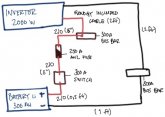almostalx
New Member
- Joined
- May 8, 2020
- Messages
- 13
Hi,
I just finished my electrical setup of 300ah lithium + 2000w inverter. I just tested my system with a 1800w toaster oven plugged into my inverter and everything was running smoothly?. The thing is some of the wires that goes from my inverter gets very hot, especially the shorter ones between my switch and my fuse (cable is around 5-6 inches). It’s not so hot that I can’t touch it, but I wouldn’t want to keep my hand on it for too long. The wires are 2/0 gauge and from my calculation are overkill for the current that it delivers (Around 170 amp for 3 feets)
So I guess my question is how hot is normal and how hot should have me worried that there’s something wrong with my wiring.
I just finished my electrical setup of 300ah lithium + 2000w inverter. I just tested my system with a 1800w toaster oven plugged into my inverter and everything was running smoothly?. The thing is some of the wires that goes from my inverter gets very hot, especially the shorter ones between my switch and my fuse (cable is around 5-6 inches). It’s not so hot that I can’t touch it, but I wouldn’t want to keep my hand on it for too long. The wires are 2/0 gauge and from my calculation are overkill for the current that it delivers (Around 170 amp for 3 feets)
So I guess my question is how hot is normal and how hot should have me worried that there’s something wrong with my wiring.



